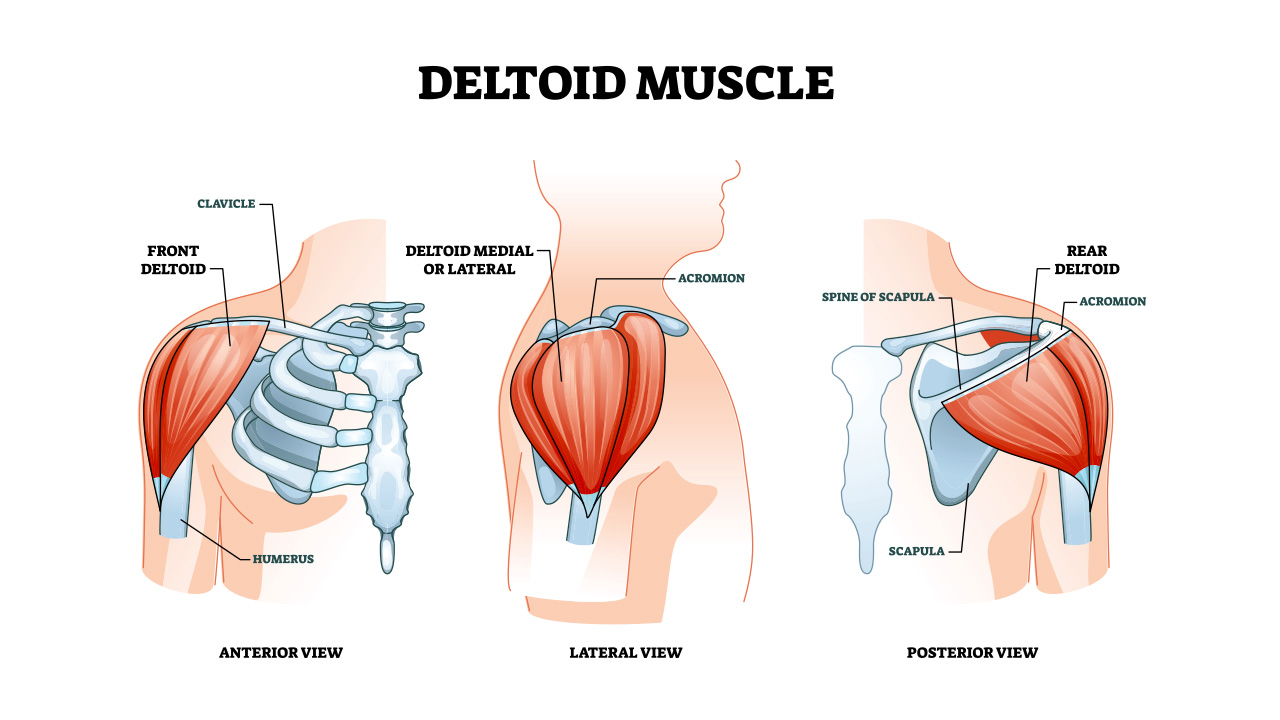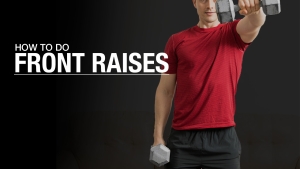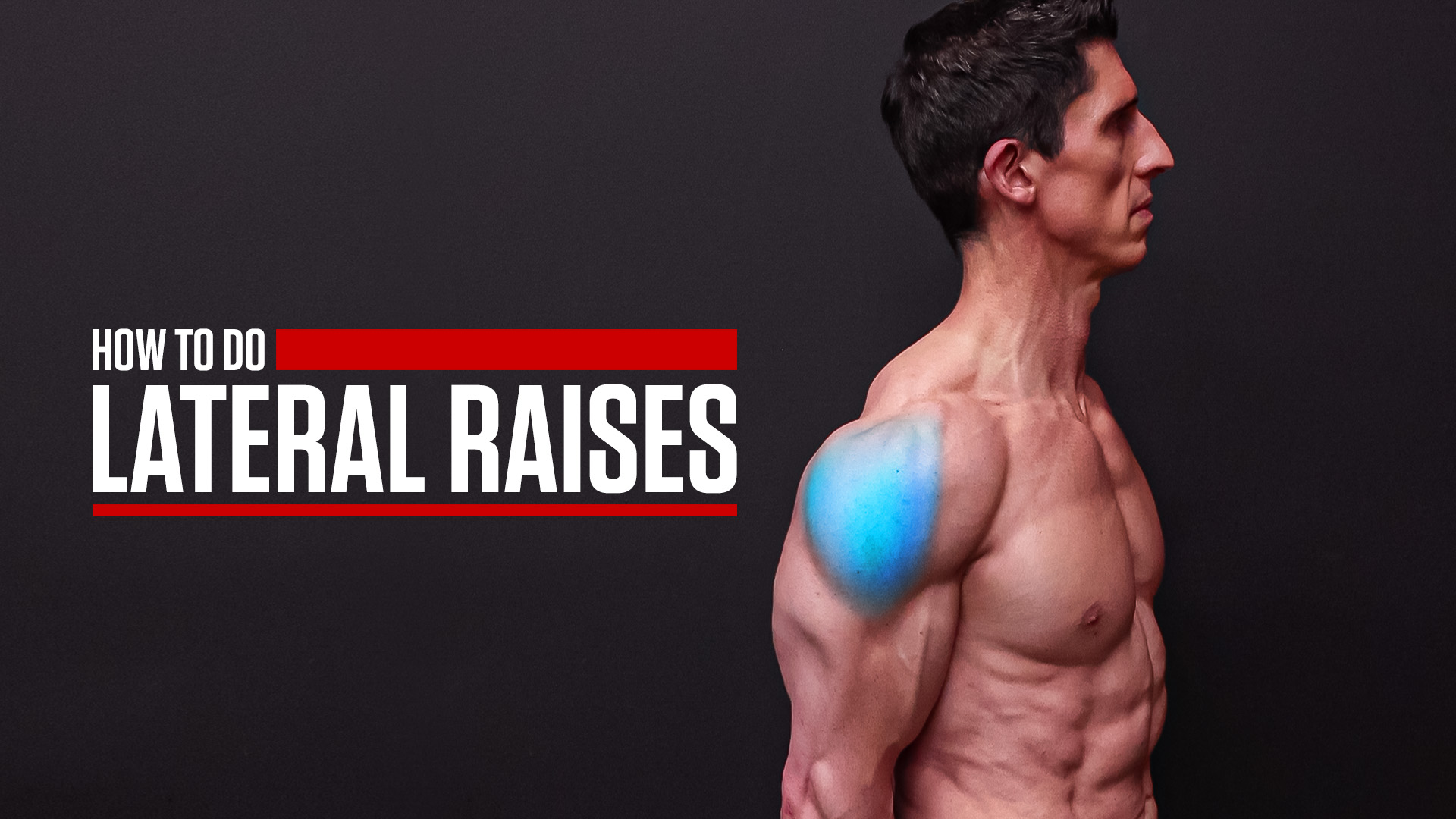
A SAFE LATERAL RAISE
Guys, I want you to take a second and pretend you’re performing a standard Dumbbell Lateral Raise.
Do it right now as you’re reading this – no pair of dumbbells required.
Pay attention to your form and ask yourself afterward:
“Did I lift my arm and then tilt my hand forward, pretending like I was pouring water from a pitcher at the top of the movement?”
If you did, you just made one of the biggest Lateral Raise mistakes. And it’s time to fix it.
Let’s do a systematic review of the anatomy of the shoulder muscles to understand how deltoid exercises function and which Lateral Raises complement, not sabotage, these muscles.
I’ll also cover the best tips and tricks to ensure your shoulder workouts are safe and effective for maximum results.
ANATOMY OF THE SHOULDER MUSCLE
Before we dive into the best Lateral Raise with dumbbells, let’s break down the muscle anatomy of the deltoids.
Why should you learn about muscle anatomy instead of jumping straight into the exercises?
It’s all about the mind-to-muscle connection.
I can’t stress enough how crucial it is to develop and practice this connection.
It’s a concept I emphasize in all my training programs and one that you need to integrate into every workout.
The mind-to-muscle connection involves consciously engaging and contracting your muscles while lifting.
This helps you target and control the specific muscle groups as you move through each rep, maximizing the effectiveness of your workout.
In other words, focus and think about how the muscle is working. You need to feel the muscle doing its job.
By understanding the structure and function of your deltoids, you can enhance this connection and get the most out of your shoulder workouts.
The deltoid muscle consists of three distinct heads:
- Anterior Deltoids
- Lateral Deltoids
- Posterior Deltoids
These three sections work together to support various movements and play an important role in the entire shoulder complex, especially during the Lateral Raise exercise.
Each head has its unique function, contributing to a balanced, powerful upper body.
Let’s break down each head or section, starting with the lateral delts – the main muscle we’ll be focusing on today.
LATERAL DELTS (SIDE DELTS)
The lateral deltoids, or side delts, are responsible for abduction movements, which involve lifting your arms away from your body. They also aid in medial rotation of the shoulder joint.
The middle deltoid fibers are essential for achieving that wide, broad-shouldered look.
Our primary focus in this article will be on the side delts, but understanding the other two heads is equally important.
ANTERIOR DELTS (FRONT DELTS)
The anterior deltoids are located at the front of your shoulders. They handle the following functions:
- Shoulder flexion (lifting your arm forward)
- Horizontal adduction (moving your arm towards the body)
- Medial rotation (rotating your shoulder inward)
Many people think their chest day workouts are enough to develop their front delts and achieve broad shoulders.
But the truth is, you need to put in extra effort to see significant results.
Incorporating a dedicated shoulder workout day into your routine can make all the difference.
The most common exercise for this muscle is the Frontal Raise.
The Frontal Raise activates the anterior delts and isolates the muscle, allowing you to build up the intensity needed to make it grow and get stronger.
POSTERIOR DELTS (REAR DELTS)
The posterior heads, or rear delts, are situated at the back of your shoulders.
These muscles are responsible for shoulder extension (lifting your arm behind you) and external rotation (rotating your arm outward).
I emphasize the importance of rear delts frequently because they are critical for preventing injuries.
Strengthening your rear delts reduces the strain on your anterior delts, providing a balanced and safe shoulder workout.
BEST LATERAL RAISES (AND HOW TO DO THEM)
By understanding the anatomy and function of your delts, you can better target these muscles and achieve a well-rounded, powerful shoulder profile.
When performed correctly, the Lateral Raise forces your side delts to grow, giving you a wider appearance (and helps you fill up those shirts).
Now, let’s get into how the best types of Lateral Raise exercises to add into your workout in order to build those side delts to their full potential.
I’ll go over how to do this excellent exercise and then explain some nuances of exercise execution that are usually overlooked.
STRAIGHT-ARM LATERAL RAISE

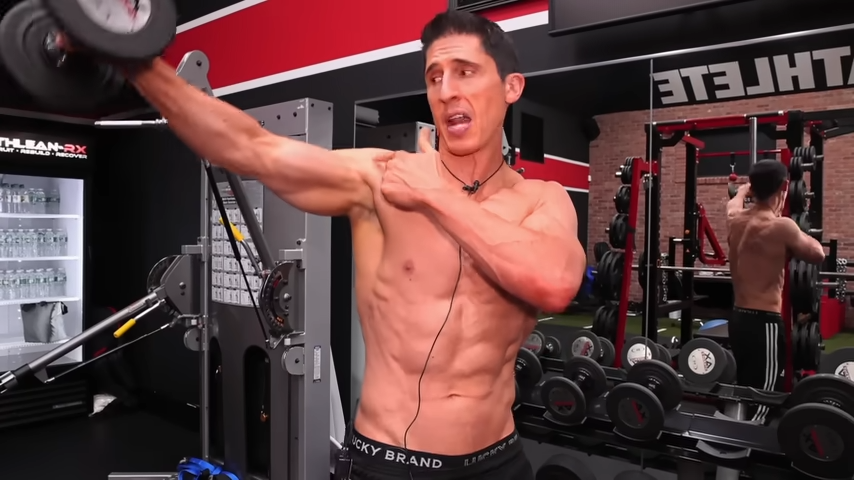
HOW TO DO THE STRAIGHT ARM LATERAL RAISE:
- Stand tall in the starting position. Keep your feet shoulder-width apart for stability.
- Grab a pair of light weights with a neutral grip (palms facing your body).
- Let your arms hang straight down at your sides, with a slight bend in your elbow joints.
- Engage your core muscles and maintain full-body tension to keep your body stable.
- Raise your arms to shoulder level, keeping them straight with a soft bend at the elbows. Move in a plane-like position to ensure correct form.
- Concentrate on engaging the lateral deltoid muscles, avoiding any momentum-generating motion.
- Hold the weights at shoulder level for a moment, ensuring maximal muscle activity and tension. Think of this part as a Dead-Stop Lateral Raise.
- Slowly lower the dumbbells back to the starting position, maintaining controlled motion throughout.
WHAT MAKES IT EFFECTIVE: The Straight-Arm Lateral Raise is effective because it targets the lateral head of the deltoid, keeping tension high on the muscle and ensuring maximal muscle recruitment and growth, especially when performed with controlled motion and a focus on the top half of the range. Keep in mind that if you don’t have a dumbbell, you can perform this as a Band-Side Lateral Raise.
When performing the Straight-Arm Lateral Raise, one of the most common shoulder muscles rehabilitation exercises, the correct weight to start with is a lighter weight.
This is because as the the length of your arm increases, the weight you can handle decreases.
And improper weight selection can lead to strain or injury.
Don’t be discouraged by using lighter weights; your shoulders can’t read the numbers on the dumbbell.
They only feel the tension in the lateral deltoid muscles, and as long as the tension is high enough, your deltoids will grow even with lighter weights.
To make this exercise more effective, understand how the dumbbell variation impacts your shoulders.
When using dumbbells, the easiest part of the exercise is at the bottom due to reduced gravitational resistance.
If you choose a weight that challenges you at the top, it might be too light at the bottom, leading to insufficient muscle engagement throughout the full range of motion.
Here, people often confuse the effective range of motion of an exercise with the full range of motion of a joint.
For the Straight-Arm Lateral Raise, limit the motion to the top half of the range with the perfect weight.

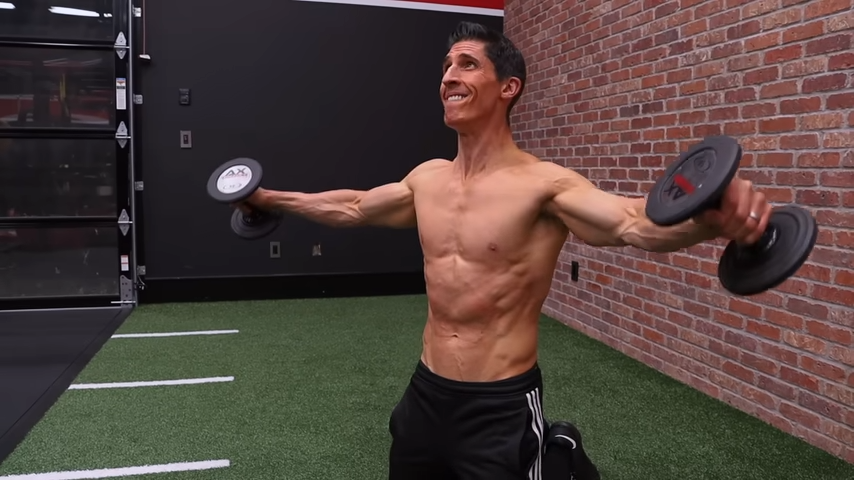
This keeps the time under tension on your deltoids high, ensuring effective shoulder muscle recruitment.
You can perform the full motion if desired, but focusing on the top half will provide more significant muscle activation and strength gains.
Remember, stick with light weights here to ensure protection from injury.
BENT-ARM SIDE RAISE

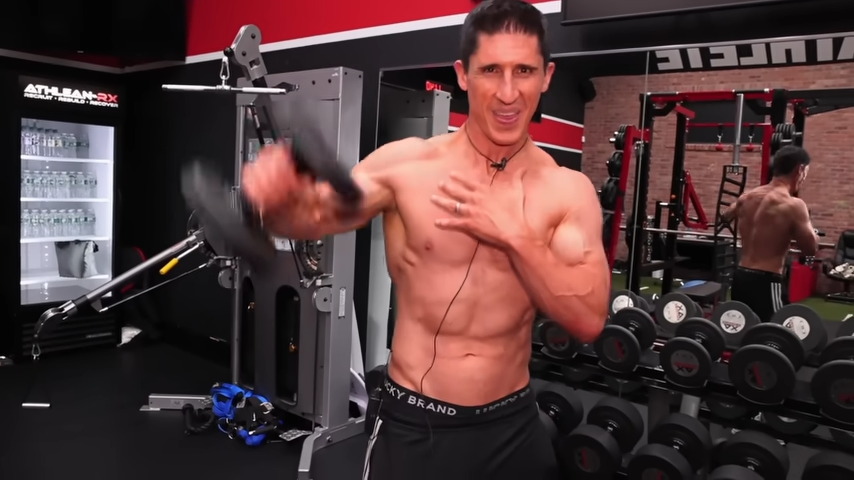
HOW TO DO THE BENT-ARM SIDE RAISE:
- Stand tall and position your feet shoulder-width apart for stability.
- Grab your weights, using heavier weights compared to what you would use for a Straight-Arm Lateral Raise. For example: If you use 20-pound dumbbells for Straight Raises, increase to 30 pounds for Bent Arm Raises.
- Maintain full-body tension to keep your body steady throughout the movement.
- Raise your arms to shoulder height with a bend in your elbows. Ensure your thumbs are higher than your pinkies to prevent internal shoulder rotation.
- Keep your wrist and hand above your elbow. This alignment protects the rotator cuff and prevents strain on the anterior deltoid.
- Keep the dumbbells in line with your torso, allowing your elbows to drift slightly behind to effectively target the lateral deltoids.
- Lift and lower the weights smoothly, maintaining a controlled motion to maximize muscle engagement.
WHAT MAKES IT EFFECTIVE: The Bent-Arm Side Raise, also known as the Bent-Arm Lateral Raise, is an effective shoulder exercise that targets the lateral deltoid while minimizing strain on the rotator cuff. Here’s how to perform it with correct form to build strength and avoid potential injuries.
When performing the Bent Arm Lateral Raise, start by increasing the weight compared to what you would use for a Straight-Arm Lateral Raise.
Due to the shortened movement arm, you can handle heavier weights while maintaining the same slight tension on your deltoid muscles.
For example, if you use 20-pound dumbbells for Straight Raises, you might increase to 30 pounds for Bent Arm Raises.
This adaptation ensures effective muscle engagement despite the increased weight.
Be mindful of form to maximize the effectiveness of this exercise and avoid potential injuries.
Keep your wrist and hand above your elbow, ensuring your thumbs are higher than your pinkies.
This alignment prevents unwanted internal shoulder rotation, which can strain the rotator cuff and anterior deltoid.
Additionally, maintain the dumbbell in line with your torso, allowing the elbow to drift slightly behind to ensure the lateral deltoid muscles are targeted.
This exercise technique prevents the anterior deltoid from taking over, keeping the focus on building broader shoulders and enhancing the lateral head of the deltoid.
By focusing on these form cues, you’ll optimize the tension and muscle recruitment, making the Bent Arm Lateral Raise a powerful isolation exercise for building shoulders that are strong and muscular.
CABLE LATERAL RAISES

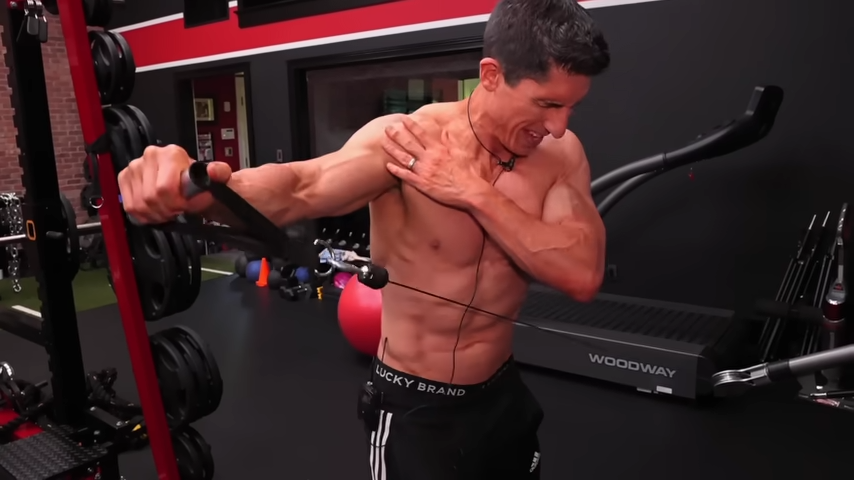
HOW TO DO THE CABLE LATERAL RAISE:
- Set up the cable, attaching a single handle to the low pulley of a cable machine.
- Position yourself with your feet shoulder-width apart. Hold the handle with one hand, keeping your arm straight with a slight bend at the elbow.
- Ensure the cable is perpendicular to your forearm at the starting position to maintain constant tension.
- Keep your body steady and maintain full-body tension.
- Raise your arm to shoulder height, moving in a smooth motion. Keep a slight bend in your elbow to avoid straining your shoulder joint.
- Hold the handle at shoulder level for a moment, ensuring maximal muscle engagement.
- Slowly lower the handle back to the starting position, maintaining a controlled motion to keep the tension on your deltoids.
WHAT MAKES IT EFFECTIVE: Cable Lateral Raises are highly effective for the lateral deltoids because the cable provides consistent tension throughout the entire range of motion, ensuring optimal muscle engagement and development from start to finish. If you don’t have access to a cable machine, consider using a resistance band, which offers similar benefits through variable resistance.
The Bent Arm Lateral Raise is great, but it still suffers from issues with the resistance curve and strength curve when using dumbbells. So how can we fix that? Enter the Cable Lateral Raise. Unlike dumbbells, the cable provides a consistent line of resistance that can transform your lateral raise.
Here’s the key: the cable remains perpendicular to your forearm throughout the simple movement. This means you have tension right from the start of the exercise, which is often missing with dumbbells. With cables, your shoulders are under tension even at the beginning of the movement, ensuring effective muscle engagement from the get-go.
When your shoulders are at their strongest—mid-movement—the cable’s tension is perfectly aligned, maximizing muscle activity. Even at the top of the movement, where your shoulders are not as strong, the cable still provides some tension, though slightly reduced. This makes the Cable Lateral Raise a superior option for maintaining tension throughout the entire range of motion.
By switching to cables, you ensure that your lateral deltoids are consistently challenged, enhancing shoulder muscle recruitment patterns, and promoting better overall shoulder development. This adjustment not only makes the exercise more effective but also helps in preventing potential injuries by providing a smoother, controlled motion.
Add this to your shoulder workout regime to see significant improvements in shoulder strength and mobility.
If you’re new to Lateral Raises or if you’re recovering from a shoulder injury, this is going to seem like advanced resistance training techniques.
So, be sure to go light, go slow, and focus on perfect form before trying the heavier variations.
BENT-ARM CABLE SIDE RAISE

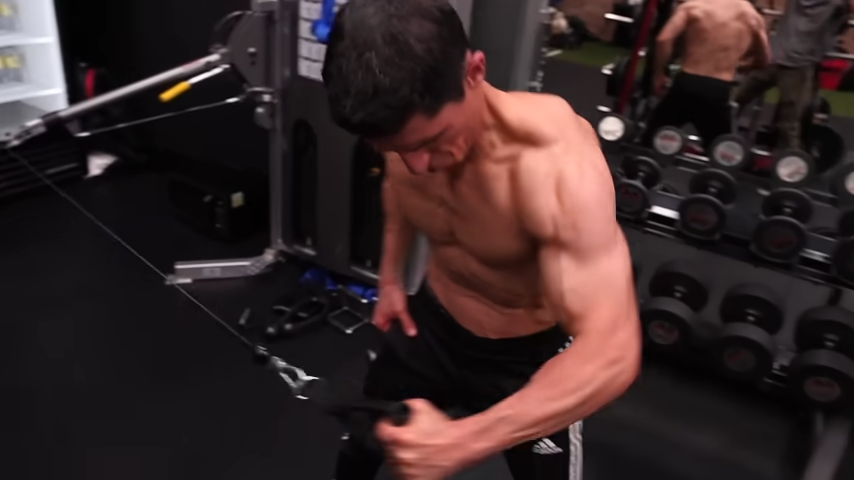
HOW TO DO THE BENT-ARM CABLE SIDE RAISE:
- Attach a single handle to the low pulley of a cable machine.
- Stand with your feet shoulder-width apart and grab the handle with one hand. Keep your arm straight with a slight bend at the elbow.
- Make sure the cable is perpendicular to your forearm at the starting position to maintain constant tension.
- Keep your body steady and maintain full-body tension.
- Start by bringing your arm across your body to get a deeper stretch in the lateral deltoids.
- Raise your arm to shoulder height, maintaining the slight bend in your elbow. This keeps the cable’s resistance high throughout the movement.
- Ensure the cable stays perpendicular to your forearm, especially at the top of the movement. This keeps tension on the lateral deltoids even at the peak.
- Pause for a moment at shoulder height to maximize muscle engagement.
- Slowly lower the handle back to the starting position, focusing on controlled eccentric movements to add another stimulus for growth.
WHAT MAKES IT EFFECTIVE: The Cable Bent-Arm Lateral Raise is an effective strength training isolation exercise because it combines the benefits of a bent arm with consistent cable resistance, ensuring constant tension and maximal muscle engagement throughout the entire range of motion. Again, if you don’t have access to a cable machine, consider Lateral Raises with resistance bands.
If you want to maximize your shoulder gains, you’ve got to consider one last variation: the Cable Bent-Arm Lateral Raise.
Eccentric resistance training increases the benefits of the bent arm and the consistent resistance of the cable.
By bending your arm, you can bring it across your body, getting a deeper stretch at the start.
When you lift to the top, the perpendicular angle of the cable keeps tension high, even at the peak of the movement.
Here’s the magic: starting with your arm across your body engages your lateral deltoids more effectively, thanks to the increased range of motion and consistent tension.
As you lift, the bent arm lever ensures more tension at the top, unlike the straight-arm version. This means more muscle activity and better shoulder muscle recruitment patterns.
With this variation, you can also handle heavier weights due to the bent arm position.
This allows for controlled eccentric movements, adding another stimulus for growth.
If I had to crown a winner, the Cable Bent-Arm Lateral Raise takes the title for the best Lateral Raise exercise.
But remember, every version has its place and can help you build bigger, stronger shoulders when executed correctly.
AVOID THIS TYPE OF LATERAL RAISE
There’s one type of Lateral Raise that I still see being performed in gyms, and I want to put a stop to it.
What is it?
You take your standard Lateral Raise and then you add in a pour movement at the top.
It looks like this:

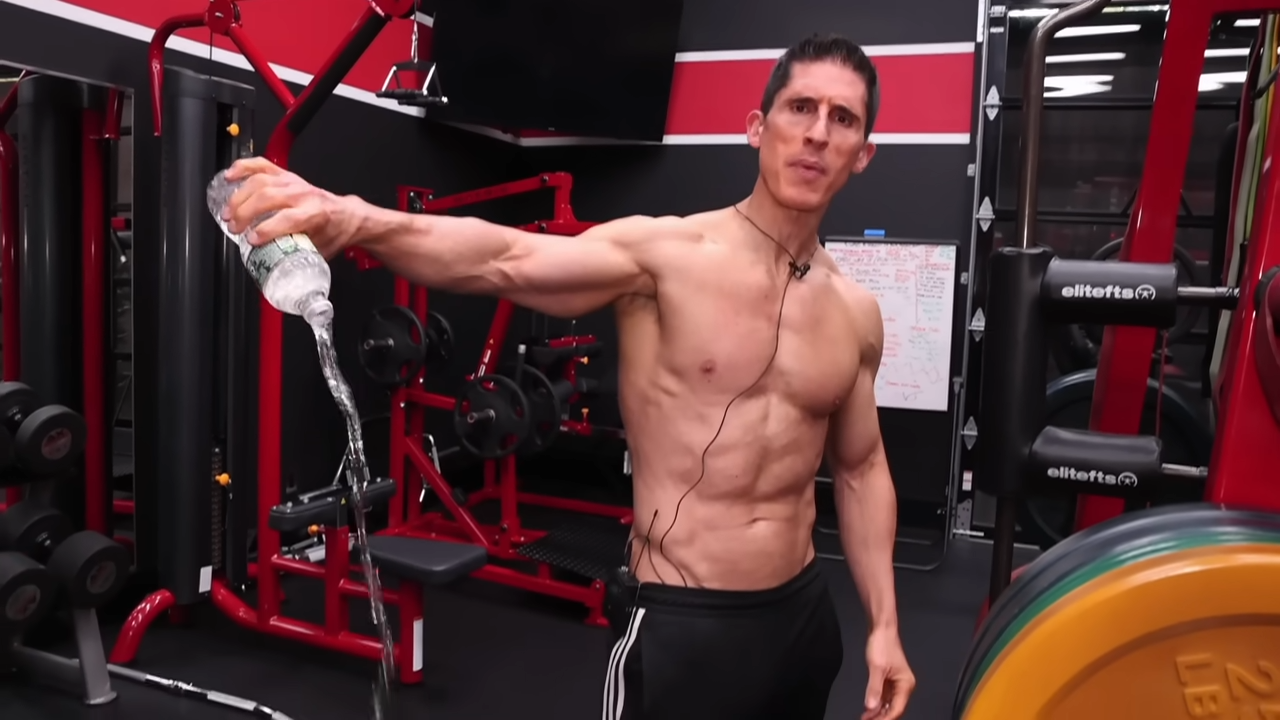
The Standing Dumbbell Lateral Raise is a staple in shoulder strength workout routines, but adding a pouring movement at the top can be detrimental to your shoulder health.
I’ve mentioned before that you should never pour the pitchers when performing this exercise, and here’s why:
When you add an internal rotation to the Lateral Raise, it changes the dynamics of the movement, causing your shoulders to internally rotate with elevation.
This motion places unnecessary strain on the rotator cuff and can lead to potential injuries.
The rotator cuff muscles are crucial for shoulder stability and mobility, and subjecting them to undue stress can result in shoulder pain and long-term damage.
Here are the key issues with the Pouring Lateral Raise:
- Increased Risk of Injury: The internal rotation combined with shoulder abduction (lifting your arms to shoulder level) can impinge the rotator cuff muscles. This can lead to shoulder impingement syndrome, a common shoulder complaint among weightlifters and competitive bodybuilders.
- Impaired Shoulder Mobility: Regularly performing this movement can compromise shoulder mobility and shoulder flexibility, making it difficult to execute other shoulder exercises or daily activities without discomfort.
- Incorrect Muscle Activation: The goal of the lateral raise is to target the lateral deltoids, but adding a pouring motion shifts the focus away from the lateral head and onto the rotator cuff muscles, reducing the effectiveness of the exercise.
HOW TO CORRECT IT
Are you guilty of making this mistake? Don’t worry – You’re not the only one!
Here’s what I want you to do in order to correct this issue:
Avoid any angles that force internal rotation at the top of the movement.


Keeping your thumbs slightly higher than your pinkies will help maintain the correct Lateral Raises form and protect your shoulder joint.
Keep your arms at a slight bend and raise your arms above shoulder height without any additional rotation.
This ensures that the tension remains on the lateral deltoid muscles, promoting muscle growth and maximal strength without risking injury.
Focus on smooth, controlled motions rather than momentum-generating movements.
This helps in maintaining consistent tension on the targeted muscles and improves shoulder muscle recruitment patterns.
BEST SIDE RAISES FOR WIDER SHOULDERS
What makes for an amazing exercise to achieve wide, well-developed shoulders?
First, you need to focus on abduction movements to effectively target the lateral deltoids.
Variety is also crucial—incorporating different angles and lateral raise variations into your routine can yield better results than relying on just one exercise.
Additionally, a comprehensive shoulder workout should include exercises that utilize both light dumbbells and heavy weights, ensuring you’re not stuck in the middle ground without progress.
With that in mind, let’s kick off this list with an exercise that’s perfect for waking up the lateral delts:
SIDE DELT ACTIVATION DRILL

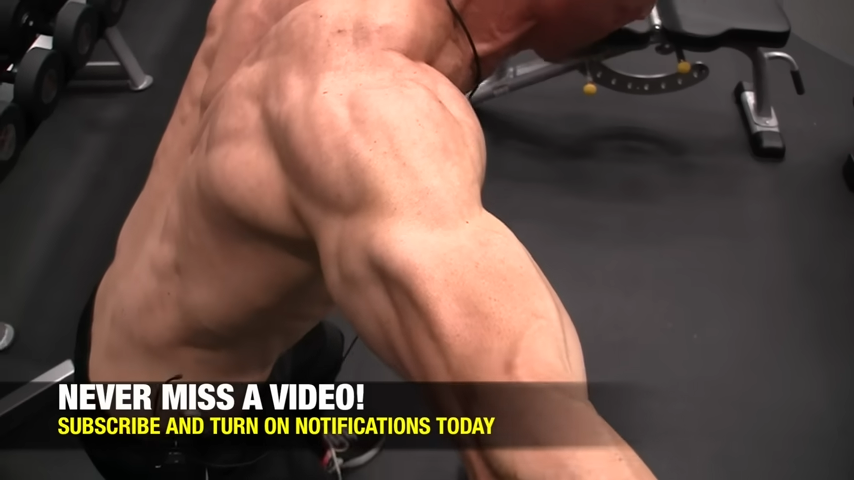
HOW TO DO THE SIDE DELT ACTIVATION DRILL:
- Begin by lifting your arm and feeling the contraction in your deltoid.
- While maintaining the contraction, slowly extend your arm out as far as possible. Hold this position.
- From this extended position, raise your arm another inch or two to intensify the contraction.
WHAT MAKES IT EFFECTIVE: This muscle hypertrophy-focused exercise is effective because it forces you to take your time and engage your mind-to-muscle connection, ensuring that you maximize muscle activation and growth in the deltoid.
ABDUCTION ROW

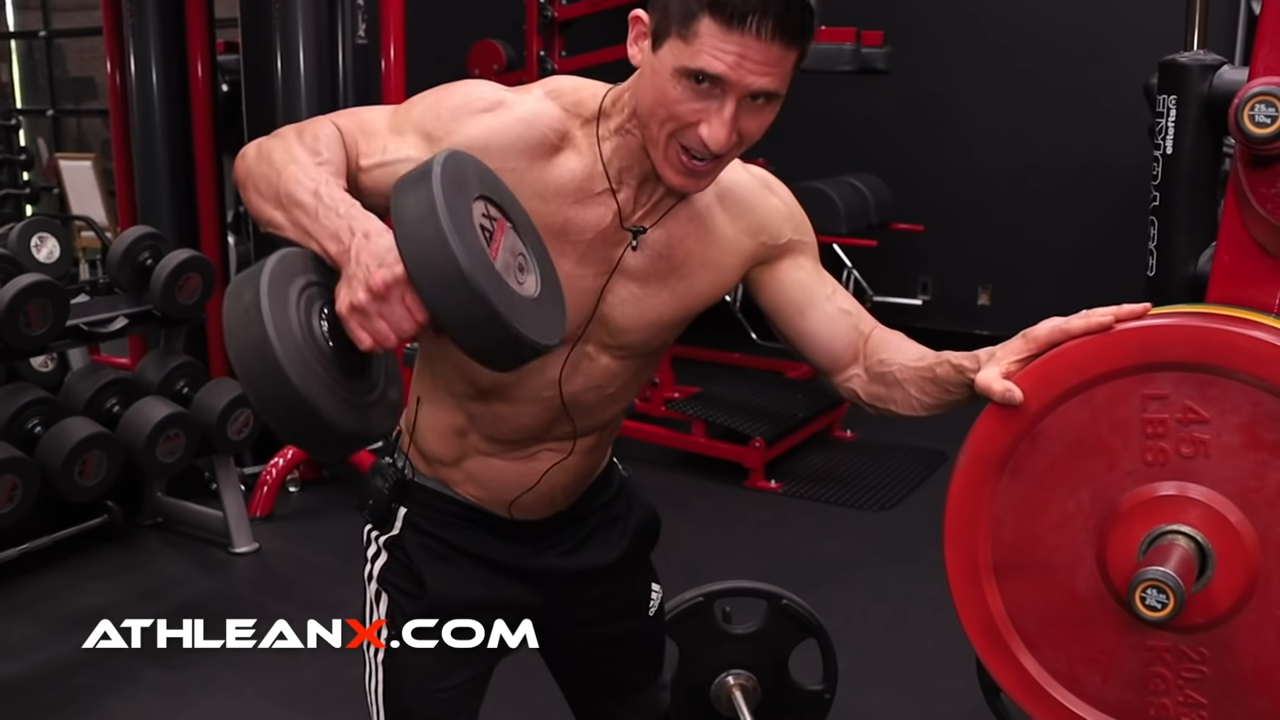
HOW TO DO THE ABDUCTION ROW:
- Position your feet shoulder-width apart to ensure a stable base.
- Use an appropriately heavy dumbbell with an overhand grip.
- Lean your body forward at about a 30-degree angle. You can use an incline bench for support to help with balance.
- Note: I only want you leaning forward during this Abduction Row. During a normal Lateral Raise, do NOT lean forward. (More on this below!)
- Let the dumbbell hang straight down in front of your thigh.
- Simultaneously row and abduct the weight away from your body with your elbows above shoulder level.
- Keep your body at a 30-degree angle throughout the movement.
- Perform six to eight reps, staying within this range for optimal muscle engagement.
WHAT MAKES IT EFFECTIVE: The middle deltoid is subjected to a significantly heavier load than usual in this exercise. This is manageable because the rear deltoid provides support. Additionally, the exercise only slightly engages the back muscles and minimizes lat involvement. This is achieved by allowing the arm to drift away from the body, rather than keeping it tight to the side where the lats would typically take over.
EXTENDED SIDE DELT RAISE

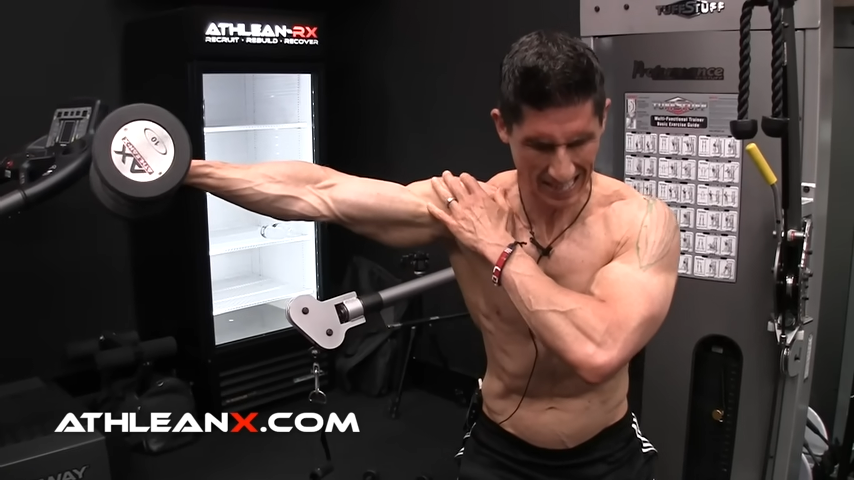
HOW TO DO THE EXTENDED SIDE DELT RAISE:
- Begin by leaning your torso forward a bit.
- Lift the dumbbell to the side, ensuring your thumb is higher than your pinky.
- Keep your arm as straight as possible, moving in a slow and controlled manner.
- Once you reach the top, hold the position for a second, then lift your arm another inch or so.
WHAT MAKES IT EFFECTIVE: This hypertrophy-focused exercise exaggerates the range of motion and distribution of weight for the middle deltoid, making it ideal for developing wider shoulders.
LATERAL RAISES: COMMON MISTAKES
When training for broader and more flexible shoulders, the most common mistakes come from your body trying to compensate by using other muscles, which kills your gains.
What’s more, if you ever have shoulder pain, you definitely need to correct these mistakes before they do more damage to your shoulders.
Let’s break down these mistakes and how to fix them to maximize your shoulder workouts.
EXTERNAL ROTATION

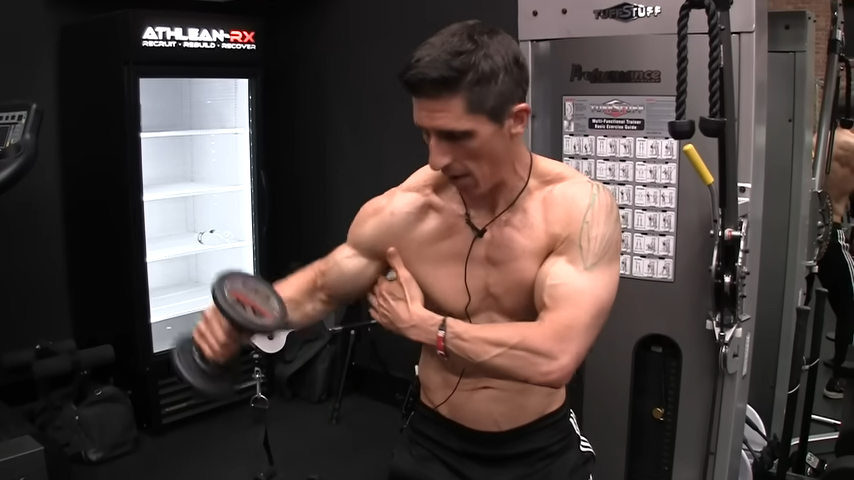
A lot of make the mistake of adding external shoulder rotation during Lateral Raises, especially in a slightly bent-over position.
While some abduction is happening, it quickly turns into external rotation at the top.
Not that external rotation is bad, but when guys you want to isolate the middle delt, you don’t want any external or internal rotation.
This is particularly problematic for anyone with shoulder impingement, as it can exacerbate the issue.
Instead, focus solely on the abduction motion to keep the tension on the lateral deltoid.
LEANING FORWARD

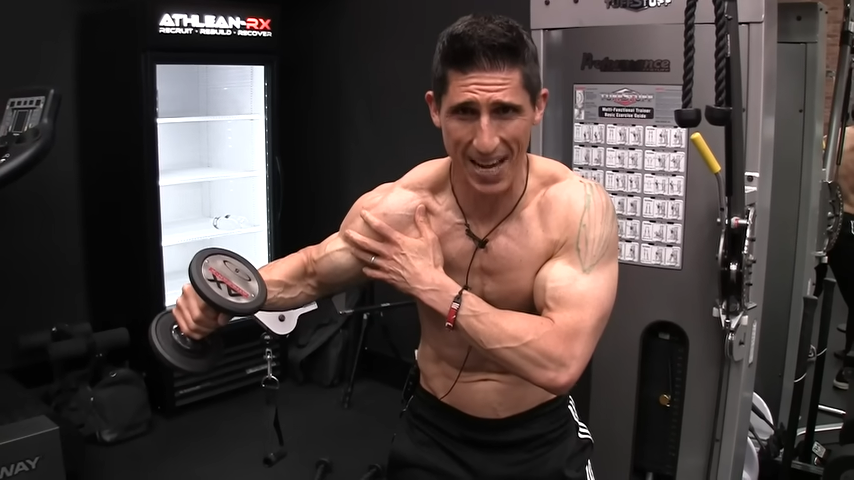
Another common mistake is leaning.
When people can’t lift their arms any higher, they tend to lean in the opposite direction.
This doesn’t increase shoulder abduction; it just shifts your body, giving the illusion of a higher lift.
Now, keep this in mind: If you’re intentionally performing the Abduction Row, this slight lean is okay.
But if your goal is to perform the traditional Lateral Raise, then you do NOT want to lean.
Even with a slight bend in your elbow flexion, leaning prevents you from properly activating the lateral delts.
Focus on keeping your body steady and maintaining the form correct without leaning to ensure you’re targeting the right muscles.
SHRUGGING

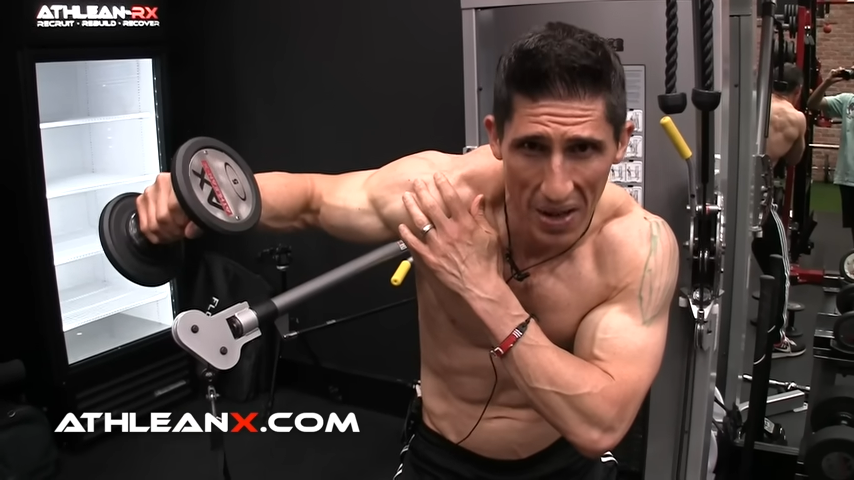
The most popular substitution error is shrugging, which engages the traps instead of the delts, which is just poor form.
When you reach a point where you can’t lift the dumbbell any higher, you might start shrugging to artificially raise the weight.
This happens a lot when your middle delts are weaker than you think.
Avoid this by keeping your shoulders down and focusing on lifting with your delts, not your traps.
By avoiding these common mistakes and focusing on perfect form and smooth motion, you’ll prevent shoulder pain and potential injuries.
Keep your movements controlled and your body stable to maximize this effective shoulder-strengthening movement.
Incorporate a variety of shoulder exercises and Lateral Raise variations to fully develop your shoulder muscles and achieve those broader shoulders.
With four excellent options to choose from, you can incorporate each one into your shoulder workouts to efficiently build up those lateral delts.
Not sure when to use which exercise?
If you’re looking for comprehensive programs that integrate exercises at the optimal times, explore our collection of ATHLEAN-X workouts.

- There are four primary ways to perform Lateral Raises that ensure safety, effectiveness, and results, but not all of them should be performed the same.
- When performing the traditional Standing Dumbbell Shoulder Lateral Raise, be sure to use light weight and high intensity. Also, focus on the top half of the movement.
- For the Dumbbell Bent-Arm Lateral Raise, you should use heavier weight, but be sure to maintain your wrist and hand above your elbow, making sure your thumbs stay higher than your pinkies.
- Next up is the Cable Lateral Raise. The key is to keep the cable perpendicular to your forearm throughout this safe movement, ensuring tension right from the start, unlike with dumbbells.
- Finally, there is the Bent-Arm Cable Lateral Raise, which provides the best parts of all the other Lateral Raise variations.
- By bending your arm, you can bring it across your body for a deeper stretch at the start, and when you lift to the top, the cable’s perpendicular angle keeps tension high, even at the peak of the movement.
- This ensures more muscle activity and better shoulder muscle recruitment patterns, thanks to the increased range of motion and consistent tension.
- Above all, avoid incorporating the pouring technique into your Lateral Raises. Here’s why:
- This motion puts excessive strain on the rotator cuff, increasing the risk of injuries.
- Incorporate each of the types of Lateral Raises into your shoulder workouts to develop full, well-rounded medial deltoids.
HOW TO DO LATERAL RAISES FAQS
Lateral Raises primarily target the lateral deltoids, or side delts, which are crucial for achieving a broad-shouldered look.
By engaging in abduction movements—lifting your arms away from your body—this exercise isolates and strengthens the middle fibers of the deltoids.
Additionally, while the focus is on the lateral head, the anterior (front) and posterior (rear) deltoids also play supportive roles during the movement.
Understanding the anatomy and function of your deltoids helps you enhance your mind-to-muscle connection, ensuring effective muscle activation and growth.
To maximize the benefits, incorporate a variety of Lateral Raise variations into your workout to target the shoulder muscles from different angles and optimize your shoulder development.
To correctly perform Lateral Raises and effectively target your lateral deltoids, start by standing tall with your feet around shoulder-width apart.
Hold light dumbbells with a neutral grip, letting your arms hang straight down with a slight bend in your elbows.
Engage your core, keep your body stable, and slowly raise your arms to shoulder level with controlled, smooth movements.
Focus on engaging the lateral deltoid muscles, avoiding momentum. Hold at shoulder level for a moment, then slowly lower the dumbbells back to the starting position.
To maintain proper form, avoid internal or external rotation by keeping your thumbs slightly higher than your pinkies, and do not lean or shrug. This ensures you are lifting with your delts, not your traps.
Consider variations like the Bent-Arm Lateral Raise modification for using heavier weights, the Cable Lateral Raise for consistent tension, and the Extended Side Delt Raise for an increased range of motion.
Lateral Raises are challenging because they require precise form and strict muscle isolation to effectively target the lateral deltoids.
This exercise involves lifting your arms away from your body, engaging the middle fibers of the deltoids, which can be tough to isolate without recruiting other muscles.
Maintaining proper form—keeping your thumbs slightly higher than your pinkies, avoiding internal or external rotation, and not leaning or shrugging—adds to the difficulty.
The controlled, slow movements needed to prevent momentum and maximize muscle engagement further increase the intensity.
Additionally, the lateral deltoids are relatively small muscles, and subjecting them to heavy loads or extensive range of motion can be demanding, making Lateral Raises an effective yet strenuous exercise for shoulder development.
When it comes to lateral raises, several variations can help you achieve well-developed shoulder muscles, but the Bent-Arm Cable Lateral Raise stands out as the best option.
This exercise combines the support of a bent arm with the consistent tension provided by the cable, ensuring constant engagement of the lateral deltoids throughout the range of motion.
Unlike the Straight-Arm Lateral Raise, which uses light dumbbells and targets the lateral head of the deltoid with controlled movements, or the Bent-Arm Side Raise, which minimizes strain on the rotator cuff (shoulder bone) and engages the posterior deltoid, the Bent-Arm Cable Lateral Raise allows for heavier weights and controlled eccentric movements.
This makes it an effective shoulder-strengthening exercise that maximizes muscle stimulation and growth.
The Cable Lateral Raise also offers consistent resistance, enhancing shoulder muscle recruitment and preventing common mistakes like leaning or shrugging.
Incorporating these variations, especially the Bent-Arm Cable Lateral Raise, into your routine will lead to significant improvements in shoulder physical strength, mobility, and overall development.
The short answer is no, and here's why:
Your shoulder muscles, particularly the lateral deltoids, need time to recover just like any other muscle group.
Hitting them every day won’t give them the necessary recovery time, which is crucial for muscle growth and avoiding overuse injuries.
Recovery is Key: Muscle growth happens during recovery. When you lift, you’re creating tiny tears in the muscle fibers. These fibers need time to repair and grow back stronger. If you don’t give them that time, you’re just breaking them down more and more without giving them a chance to rebuild.
Risk of Injury: Overworking your shoulders can lead to serious problems like shoulder impingement or rotator cuff injuries. These are common shoulder complaints among competitive bodybuilders and can sideline your training for weeks or even months. Optimal Training Frequency: Instead of doing lateral raises every day, aim for 2-3 times a week. This allows for adequate recovery while still providing enough stimulus for growth. Pair them with a variety of shoulder strength exercises to hit all the deltoid heads effectively and keep your shoulder workout balanced.If you feel shoulder pain or discomfort, take it as a sign to back off and let your muscles recover. Incorporate rest days and don’t ignore the importance of a well-rounded program that includes proper recovery time.
So, hit those lateral raises hard, but give your shoulders the entire time they need to recover and grow. That’s how you build stronger, more resilient shoulders.
It depends on the type of Lateral Raise that you’re performing.
For the Straight-Arm Lateral Raise, it's important to use lighter weights.
This exercise targets the lateral deltoids effectively by keeping tension high on the muscle, which is essential for muscle recruitment and growth.
As the length of your arm increases, the weight you can handle decreases, so lighter weights ensure that you maintain proper form and avoid momentum-generating motions.
However, for the Bent-Arm Side Raise, you can go heavier because the shortened movement arm allows you to handle more weight while still maintaining effective muscle engagement.
This variation minimizes strain on the rotator cuff and ensures the focus remains on the lateral deltoids.
Cable Lateral Raises provide consistent tension throughout the entire range of motion, making them another excellent option for engaging the shoulder muscles without needing heavy weights.
The cable's constant resistance ensures that your lateral deltoids are consistently challenged, enhancing muscle recruitment and development.
The Bent-Arm Cable Side Raise combines the benefits of heavier weights and consistent cable resistance, making it the most effective exercise variation.
This exercise allows for controlled eccentric movements and ensures maximal muscle engagement throughout the entire range of motion.
REFERENCES

Jeff Cavaliere M.S.P.T, CSCS
Jeff Cavaliere is a Physical Therapist, Strength Coach and creator of the ATHLEAN-X Training Programs and ATHLEAN-Rx Supplements. He has a Masters in Physical Therapy (MSPT) and has worked as Head Physical Therapist for the New York Mets, as well as training many elite professional athletes in Major League Baseball, NFL, MMA and professional wrestling. His programs produce “next level” achievements in muscle size, strength and performance for professional athletes and anyone looking to build a muscular athletic physique.
















